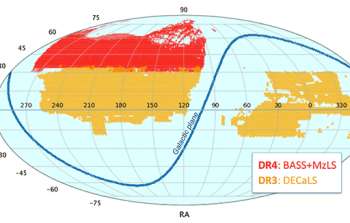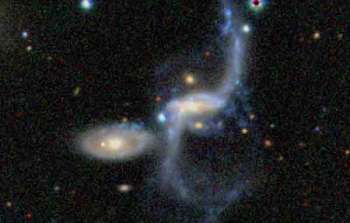sci17011 — Announcement
Fourth Data Release for the Legacy Surveys
July 31, 2017
<a href="https://www.noao.edu/currents/img/LS_DR4_DR3_coverage_Fig1.jpg">
Figure 1. Footprints of the DR3 (orange) and DR4 (red) data releases over the full sky. Note that there is some overlap around declinations of 30 to 34 degrees.
Stephanie Juneau and Arjun Dey (NOAO)
The Fourth Data Release (DR4) of the Legacy Surveys (LS) is now publicly available. Augmenting the previous data release (DR3), which featured the equatorial sky, DR4 covers an area of 3600 square degrees and extends the survey footprint northward to declinations between 30 and 80 degrees (Figure 1). Executed in preparation for the Dark Energy Spectroscopic Instrument (DESI) survey, the Legacy Surveys project is imaging nearly a third of the sky (approximately 14,000 square degrees) in three color filters using three telescopes: the Kitt Peak National Observatory’s 4-m Mayall and the Steward Observatory’s 2.3-m Bok telescopes on Kitt Peak in Arizona, and the Cerro Tololo Inter-American Observatory’s 4-m Blanco telescope on Cerro Tololo in Chile. When complete in 2018, the Legacy Surveys images will be one of the widest area deep exploratory surveys of the sky.
DESI, an unprecedented cosmographic survey of the universe, will use the Legacy Surveys imaging data to select 35 million galaxy targets for spectroscopic observations and determine their cosmological distances. This in turn will yield the most detailed measurements to date of the expansion history of the Universe. The DESI project is currently under construction and is expected to begin its survey in 2019 using the Mayall telescope.
DR4 includes imaging in the z-band (approximately 850-1000nm) from the Mayall z-band Legacy Survey (MzLS; PI A. Dey) undertaken with the Mayall telescope, and in the g and r bands (400-550nm and 570-710nm, respectively) from the Beijing-Arizona Sky Survey (BASS; co-PIs Z. Xu & X. Fan) carried out on the Bok telescope. DR4 also includes mid-infrared photometry for all detected astronomical sources, derived from newly co-added images from NASA’s Wide-field Infrared Survey Explorer (WISE).
The DR4 dataset contains raw, pipeline processed, and stacked (co-added) images, model images of the sky (constructed using the Tractor, an inference-based forward modeling approach) as well as other maps described here. A total of 183.5 million sources were detected, with about half (90.7 million) fitted as point sources, and the remainder as resolved sources (mostly galaxies). Data products are available to the astronomy community and the public via the LS team website, the NOAO Science Archive and ftp server, and through the NOAO Data Lab.
Figure 2. LS DR4 color composite image using g- and r-bands from BASS, and z-band from MzLS. The prominent interacting galaxy pair is UGC 10610. There are several distant galaxies in the background, and a few foreground stars from our Galaxy.
LS DR4 supplements the previous data release, DR3, as shown in Figure 1. The complementary footprints overlap in a region that lies between declination 32-34 deg. For additional information about LS DR3, see the announcement in the October 2016 issue of Currents and the Legacy Surveys DR3 website.
The NOAO Data Lab has developed a database to query all DR3 & DR4 tables. Entry points into the database include a query manager tool, a Table Access Protocol (TAP) service, and a web Query Interface. Additional information regarding data access is compiled on a dedicated webpage maintained by the Data Lab. The survey can be explored interactively using the LS Image Viewer (example image shown in Figure 2).
The Legacy Surveys project is possible thanks to several teams, observatories, and agencies. Acknowledgements are listed in full here.
About the Announcement
| Id: |
ID
sci17011
|

